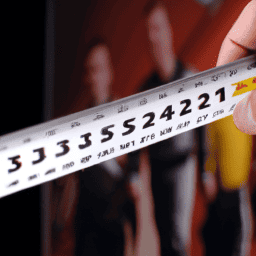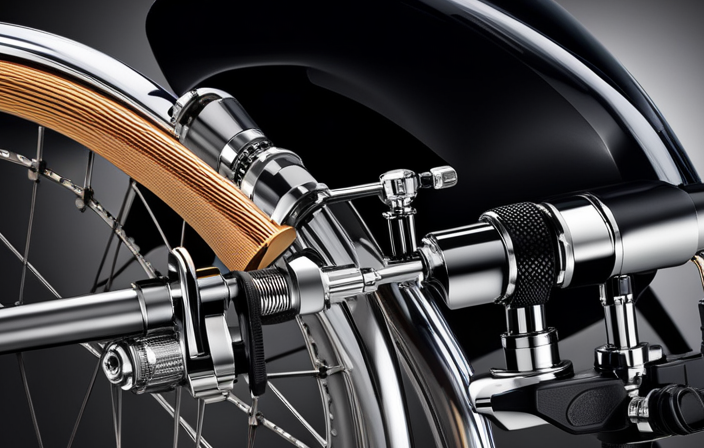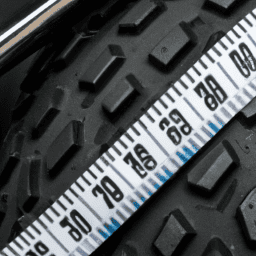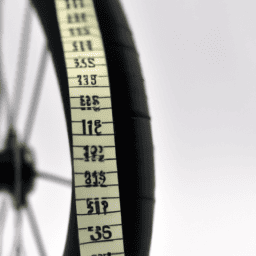As someone passionate about cycling, I recognize the significance of riding a bicycle that fits you perfectly. Using a bicycle that’s either too large or too small can cause discomfort, soreness, and potentially lead to injuries. This is why it’s crucial to measure your bicycle size before you buy one or even before making adjustments to a bicycle you currently have.
Measuring your bike size might seem like a daunting task, but it’s actually quite simple. In this article, I will guide you through the process of determining the right measurements to take, using the proper tools for measuring, and taking accurate measurements.
By the end of this article, you’ll have all the information you need to find the perfect size bike for your body and riding style.
Key Takeaways
- Proper bike sizing is important for comfort, efficiency, and injury prevention.
- Factors to consider for bike sizing include height, inseam length, arm length, and torso length, as well as personal preferences.
- Tools and techniques for measuring bike size include a tape measure and bike fitting tool, as well as calibration techniques for accuracy.
- Common mistakes to avoid when measuring bike size include not factoring in pedals or handlebars, and not measuring standover height.
Understand the Importance of Measuring Your Bike Size
You’ll want to understand the significance of measuring your bike size so that you can ensure the most comfortable and efficient riding experience possible.
When it comes to cycling, the benefits of proper bike sizing are numerous. A bike that is the right size for you allows for proper alignment of your body, reducing the risk of injury and increasing your power output. It also ensures that you can ride for longer periods without experiencing discomfort or fatigue, making cycling an enjoyable activity rather than a painful chore.
However, there are common mistakes in bike sizing that many people make. Some may think that a bigger bike is better because it provides more stability, but this can actually lead to discomfort and decreased power output. Others may simply choose a bike based on its color or appearance without considering the fit.
These mistakes can lead to an uncomfortable, inefficient, and even dangerous riding experience. To avoid them, it’s important to take the time to determine the right measurements to take and ensure that your bike fits you properly.
Determine the Right Measurements to Take
It’s important to get accurate dimensions of your ride to ensure the perfect fit and prevent discomfort or injury down the road, so take the time to properly assess your body and choose the appropriate bike.
One of the most common mistakes people make is choosing a bike based on their height alone. While height is a good starting point, it’s not the only factor to consider. Other important measurements include inseam length, arm length, and torso length. These dimensions will help you find a bike that is comfortable and efficient to ride.
Adjusting for personal preferences is also crucial when determining the right measurements for your bike. For example, if you plan to ride your bike on rough terrain, you may want a larger frame size for more stability and control. On the other hand, if you’re planning on long distance rides, you might prefer a smaller frame size for a more aerodynamic position.
By taking your personal preferences into account, you’ll be able to find a bike that fits you perfectly and meets your specific needs. With these considerations in mind, it’s important to use the proper tools for measuring to get accurate and precise dimensions of your body and bike.
Use the Proper Tools for Measuring
Using the right tools to get the perfect fit for your ride can make all the difference in your biking experience. When measuring the size of a bicycle, it is crucial to use the appropriate tools for accurate results. Calibration techniques are necessary to ensure that the tools you are using are precise and reliable. Common errors in measurement can lead to discomfort and even injury during a ride.
One of the most commonly used tools for measuring a bike is a tape measure. However, it is essential to ensure that the tape measure is calibrated correctly before use. A misaligned or damaged tape measure can lead to inaccurate measurements. Another tool that can be used is a bike fitting tool, which measures the key dimensions of the bike, such as the top tube length, saddle height, and stem length. This tool allows for a more precise and detailed measurement of the bike.
| Tool | Purpose | Accuracy |
|---|---|---|
| Tape measure | Measuring length and height | +/- 1cm |
| Bike fitting tool | Measuring key dimensions | +/- 0.5cm |
It is crucial to use the proper tools to get accurate measurements when measuring the size of a bicycle. Incorrect measurements can lead to discomfort or even injury during a ride. In the subsequent section, we will discuss how to take accurate measurements to get the perfect fit for your ride.
Take Accurate Measurements
To get a comfortable and safe ride, accurately determining the dimensions of your bike is crucial, and there are several tools available to help you achieve this.
When taking measurements, there are a few tips for accuracy to keep in mind. First, make sure the bike is on a level surface, with the wheels inflated to their recommended pressure. Next, use a tape measure or ruler to measure all dimensions, as eyeballing can lead to errors. Finally, take multiple measurements of each dimension to ensure consistency and accuracy.
There are also some common mistakes to avoid when measuring your bike. One is not factoring in the extra space taken up by the pedals or handlebars, which can cause a significant difference in the overall size of the bike. Another mistake is not measuring the bike’s standover height, which is the distance between the ground and the top tube of the bike frame. This is important for ensuring proper clearance when mounting and dismounting the bike.
By taking accurate measurements and avoiding common mistakes, you can confidently use your measurements to find the right bike for your needs.
Use Your Measurements to Find the Right Bike
Finding the perfect bike for your needs is all about utilizing your accurate measurements and selecting the right fit for your body. Once you have your measurements, you can begin to explore different bike styles and sizes.
It’s important to consider the purpose of your bike, such as commuting, racing, or leisurely rides, as well as your personal preferences and riding style. When choosing a bike, consider the accessories you may need, such as lights, a lock, or a rack.
These can affect the overall weight and balance of your bike, so it’s important to factor them in when selecting the right size. Additionally, make sure to adjust the seat height to the appropriate level for your comfort and efficiency.
With the right measurements and adjustments, you’ll be able to find the perfect bike for your needs and enjoy comfortable and efficient rides.
Frequently Asked Questions
Can I just use my height to determine the size of my bike?
I wouldn’t recommend using just your height to determine the size of your bike. Fit based on inseam length is a better approach. I suggest visiting a bike shop for a professional fitting to ensure the right size and optimal riding experience.
How do I know if the bike frame is too small or too big for me?
To determine if a bike frame is too small or too big for me, I adjust the handlebars and choose the proper seat height. If my arms are fully extended and my knees are slightly bent, the bike fits properly.
Is it necessary to measure the length of the bike’s stem?
Measuring the bike stem is crucial in finding the right handlebar size. It affects the bike’s stability and your comfort. Consider the stem length, angle, and diameter. Use a ruler or measuring tape to ensure accuracy.
What are the most common mistakes to avoid when measuring bike size?
To ensure accurate measurements of bike size, avoid common mistakes such as measuring from the wrong points or using incorrect tools. Use a tape measure and follow established guidelines for precise results. Tips for accuracy include having a second person assist and double-checking measurements.
How do I adjust the bike size if I already bought one that doesn’t fit me well?
I realized I had bought a bike that didn’t fit me well, but adjusting bike fit is possible. I sought out professional bike fitting services, and they made the necessary adjustments to ensure a comfortable and efficient ride.
Conclusion
In conclusion, it’s crucial to measure the size of your bicycle before purchasing one. This ensures that you’ll have a comfortable and safe ride, and reduces the risk of injury.
Taking the right measurements and using the proper tools are key to obtaining accurate results. By following these steps, you can determine the appropriate bike size for your body type and riding style.
Remember, finding the right bike size isn’t just about comfort, it also affects your performance and overall experience. Taking the time to measure your bike size will pay off in the long run and make your cycling journey enjoyable and fulfilling.
So, grab your measuring tape and get started on finding the perfect fit for your next adventure.









